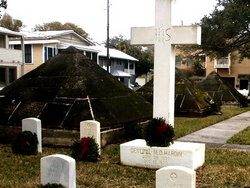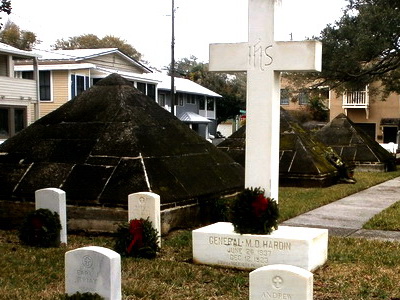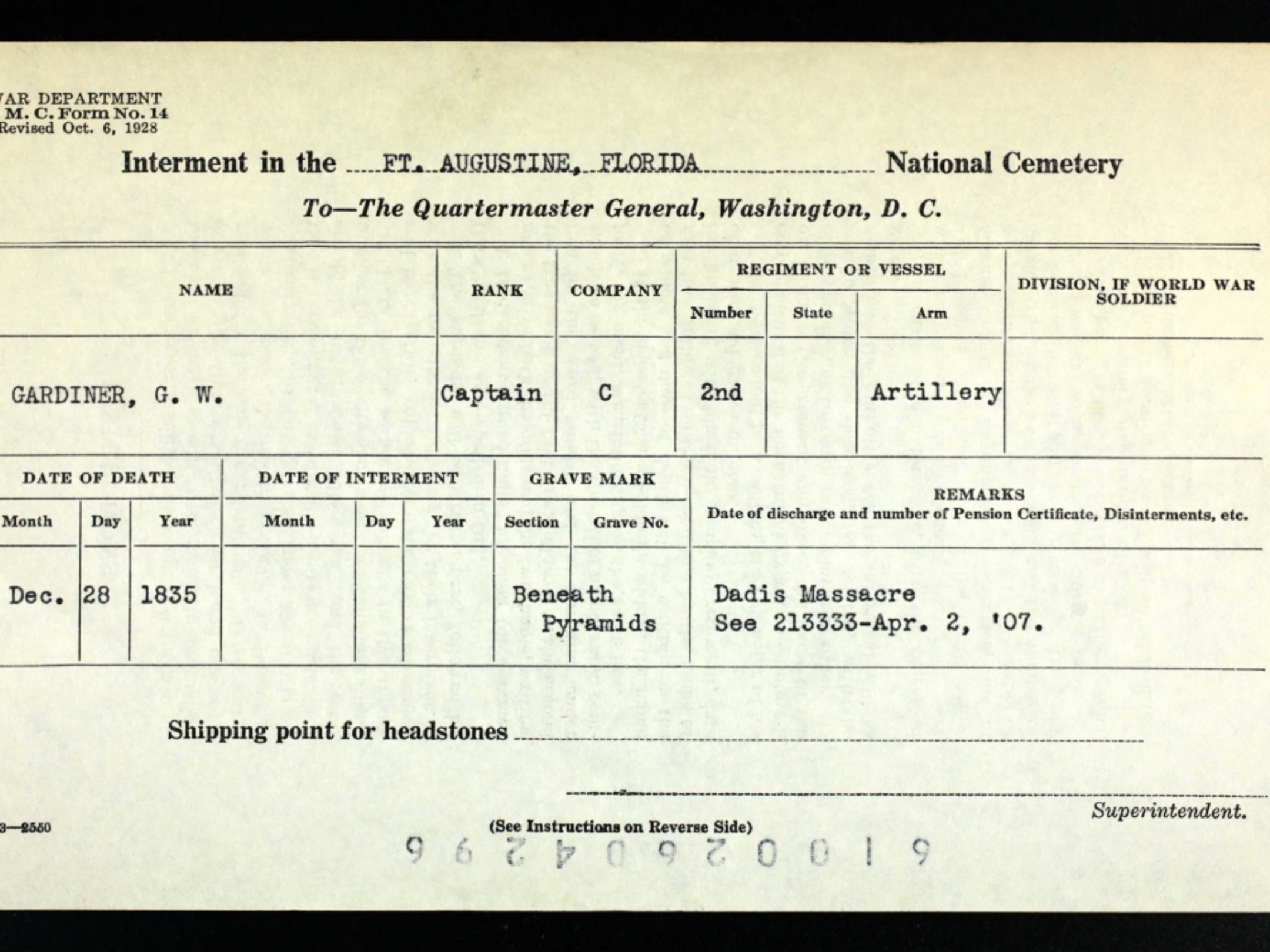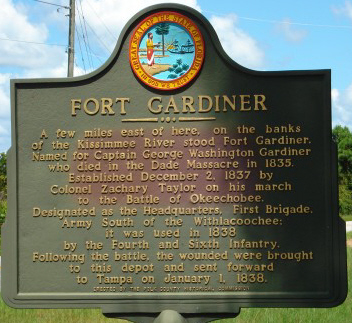~~~~~~~~~~~~~~~~~~~~~~~~~~~~~~~~~~~~~~~~~~~~~~~~~~~~~~~
On December 23, 1835, a detachment of 107 men under the command of Major Francis L. Dade set out from Fort Brooke as reinforcements for the small garrison of Fort King.
It's commonly believed that Captain Gardiner was to lead these troops to Fort King, however, due to his wife, Frances, having fallen ill, Major Dade took over his command at the last minute. Captain Gardiner dispatched his wife to Key West aboard the government transport MOTTO and soon caught up to the rest of the column.
On the morning of December 28, 1835, as the troops were advancing double file through a pine barren, the first shots rang out. The first officers to fall were Major Francis Dade, who was at the head of the column just behind the advance guard, and Captain Upton S. Fraser, who was not far behind, thus leaving Captain George W. Gardiner as ranking officer.
During a lull in the fighting, the remaining soldiers under Captain Gardiner's command, constructed a triangular breastworks from felled pine trees and as the Seminoles renewed their attack the soldiers fired from the breastworks. By 2 p.m. Captain Gardiner was severely wounded and cried out, "I can give you no more orders my lads, do your best!" (this according to the eyewitness account given by Private Ransom Clark). It is believed that Captain Gardiner fell outside the breastworks at the northwest corner.
General Hitchcock's report of his assessment of the battlefield (Feb. 22, 1836): "Along the north and west faces of the triangular breastwork formed by felled trees, were about thirty bodies, mere skeletons, although much of the clothing was left upon them. They were lying, almost every one of them, in precisely the position they must have occupied during the fight, — their heads next to the logs over which they had delivered their fire, and their bodies stretched with striking regularity parallel to each other. They had evidently been shot dead at their posts, and the Indians had not disturbed them, except by taking the scalps of most of them. . . . The advance guard, doubtless, fell during the first attack. It was during a cessation of fire that the little band still remaining — about thirty in number — threw up the triangular breastwork, which, from the haste with which it was constructed, was necessarily defective and could not protect the men on the second attack."
(Bio written by Camillia {CNP} #47877030)
~~~~~~~~~~~~~~~~~~~~~~~~~~~~~~~~~~~~~~~~~~~~~~~~~~~~~~~
Military History — Cadet of the Military Academy, Sep. 2, 1812, to Mar. 11, 1814, when he was graduated and promoted in the Army to Third Lieut., 1st Artillery, Mar. 11, 1814.
Service: War of 1812‑15 with Great Britain, in garrison at Fort Columbus, N. Y., 1814‑15; at Portsmouth, N. H., 1815‑16; at the Military Academy, 1816‑20, as Adjutant, Oct. 12, 1816, to Sep. 15, 1817, and from Feb. 10, 1819, to Mar. 9, 1820, — as Commandant of Cadets and Instructor of Infantry Tactics, Sep. 15, 1817, to Apr. 2, 1818, — and as Instructor of Artillery, Sep. 15, 1817, to Feb. 1, 1820; in garrison at New York harbor, 1820; on Commissary duty, 1820‑21; in garrison at Fort Mifflin, Pa., 1821‑24, — Fort Delaware, Del., 1824‑27, — and Augusta Arsenal, Ga., 1827‑30; in Cherokee Nation, 1830‑31; in garrison at Fort
Marion, Fla., 1831‑32, — and Augusta Arsenal, Ga., 1832‑33; in Cherokee Nation, 1833; in garrison at Fort Mitchell, Ala., 1833‑34, — Fort Jackson, La., 1834, — Covington, La., 1834, — Fort Jackson, La., 1834‑35, — and Fort Pickens, Fla., 1835; and in the Florida War, Fort Brooke, Fla., 1835.
Ranks held an timeline: Second Lieut., 1st Artillery, May 1, 1814; transferred to Corps of Artillery, May 12, 1814; First Lieut., Corps of Artillery, Apr. 20, 1818; First Lieut., 2d Artillery, June 1, 1821; Bvt. Captain, Apr. 20, 1828, for Faithful Service Ten Years in one Grade; Captain, 2d Artillery, Nov. 3, 1832.
Listed on the Roll of Honor at Dade Battlefield Historic State Park, Bushnell, Florida, site of the ambush and original burial place of Dade's Command.
Listed on U.S. Department of Veteran's Affairs Database. (Gardiner, G W, d. 12/28/1935, CAPT C 2ND ARTILLERY, Dec 28 1835, Plot: BENEAPYRAMIND, *)Note wrong date.
~~~~~~~~~~~~~~~~~~~~~~~~~~~~~~~~~~~~~~~~~~~~~~~~~~~~~~~
~~~~~~~~~~~~~~~~~~~~~~~~~~~~~~~~~~~~~~~~~~~~~~~~~~~~~~~
On December 23, 1835, a detachment of 107 men under the command of Major Francis L. Dade set out from Fort Brooke as reinforcements for the small garrison of Fort King.
It's commonly believed that Captain Gardiner was to lead these troops to Fort King, however, due to his wife, Frances, having fallen ill, Major Dade took over his command at the last minute. Captain Gardiner dispatched his wife to Key West aboard the government transport MOTTO and soon caught up to the rest of the column.
On the morning of December 28, 1835, as the troops were advancing double file through a pine barren, the first shots rang out. The first officers to fall were Major Francis Dade, who was at the head of the column just behind the advance guard, and Captain Upton S. Fraser, who was not far behind, thus leaving Captain George W. Gardiner as ranking officer.
During a lull in the fighting, the remaining soldiers under Captain Gardiner's command, constructed a triangular breastworks from felled pine trees and as the Seminoles renewed their attack the soldiers fired from the breastworks. By 2 p.m. Captain Gardiner was severely wounded and cried out, "I can give you no more orders my lads, do your best!" (this according to the eyewitness account given by Private Ransom Clark). It is believed that Captain Gardiner fell outside the breastworks at the northwest corner.
General Hitchcock's report of his assessment of the battlefield (Feb. 22, 1836): "Along the north and west faces of the triangular breastwork formed by felled trees, were about thirty bodies, mere skeletons, although much of the clothing was left upon them. They were lying, almost every one of them, in precisely the position they must have occupied during the fight, — their heads next to the logs over which they had delivered their fire, and their bodies stretched with striking regularity parallel to each other. They had evidently been shot dead at their posts, and the Indians had not disturbed them, except by taking the scalps of most of them. . . . The advance guard, doubtless, fell during the first attack. It was during a cessation of fire that the little band still remaining — about thirty in number — threw up the triangular breastwork, which, from the haste with which it was constructed, was necessarily defective and could not protect the men on the second attack."
(Bio written by Camillia {CNP} #47877030)
~~~~~~~~~~~~~~~~~~~~~~~~~~~~~~~~~~~~~~~~~~~~~~~~~~~~~~~
Military History — Cadet of the Military Academy, Sep. 2, 1812, to Mar. 11, 1814, when he was graduated and promoted in the Army to Third Lieut., 1st Artillery, Mar. 11, 1814.
Service: War of 1812‑15 with Great Britain, in garrison at Fort Columbus, N. Y., 1814‑15; at Portsmouth, N. H., 1815‑16; at the Military Academy, 1816‑20, as Adjutant, Oct. 12, 1816, to Sep. 15, 1817, and from Feb. 10, 1819, to Mar. 9, 1820, — as Commandant of Cadets and Instructor of Infantry Tactics, Sep. 15, 1817, to Apr. 2, 1818, — and as Instructor of Artillery, Sep. 15, 1817, to Feb. 1, 1820; in garrison at New York harbor, 1820; on Commissary duty, 1820‑21; in garrison at Fort Mifflin, Pa., 1821‑24, — Fort Delaware, Del., 1824‑27, — and Augusta Arsenal, Ga., 1827‑30; in Cherokee Nation, 1830‑31; in garrison at Fort
Marion, Fla., 1831‑32, — and Augusta Arsenal, Ga., 1832‑33; in Cherokee Nation, 1833; in garrison at Fort Mitchell, Ala., 1833‑34, — Fort Jackson, La., 1834, — Covington, La., 1834, — Fort Jackson, La., 1834‑35, — and Fort Pickens, Fla., 1835; and in the Florida War, Fort Brooke, Fla., 1835.
Ranks held an timeline: Second Lieut., 1st Artillery, May 1, 1814; transferred to Corps of Artillery, May 12, 1814; First Lieut., Corps of Artillery, Apr. 20, 1818; First Lieut., 2d Artillery, June 1, 1821; Bvt. Captain, Apr. 20, 1828, for Faithful Service Ten Years in one Grade; Captain, 2d Artillery, Nov. 3, 1832.
Listed on the Roll of Honor at Dade Battlefield Historic State Park, Bushnell, Florida, site of the ambush and original burial place of Dade's Command.
Listed on U.S. Department of Veteran's Affairs Database. (Gardiner, G W, d. 12/28/1935, CAPT C 2ND ARTILLERY, Dec 28 1835, Plot: BENEAPYRAMIND, *)Note wrong date.
~~~~~~~~~~~~~~~~~~~~~~~~~~~~~~~~~~~~~~~~~~~~~~~~~~~~~~~
Family Members
Advertisement
Explore more
Sponsored by Ancestry
Advertisement








